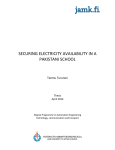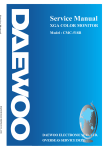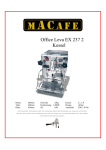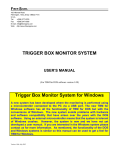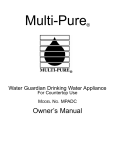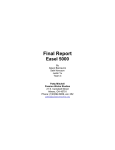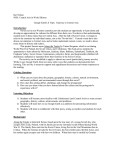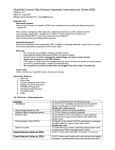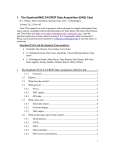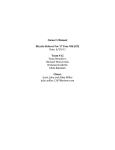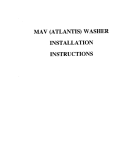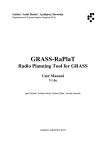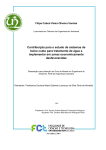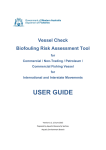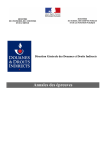Download Project Proposal and Feasibility Study Team 5
Transcript
Project Proposal and Feasibility Study Team 5: Disaster Relief Shelter Walta Asfaw David Headley Nick Liza Dan Nederhoed Engineering 339/340 Senior Design Project Calvin College December 2012 1 Table of Contents: Executive Summary ........................................................................................................................ 6 Introduction ..................................................................................................................................... 7 Background ................................................................................................................................. 8 Post-Disaster Events .................................................................................................................... 9 Cultural Aspect and Demands ................................................................................................... 10 Project Management ..................................................................................................................... 10 Team Structure .......................................................................................................................... 10 Schedule .................................................................................................................................... 11 Method of Approach ................................................................................................................. 11 Requirements ................................................................................................................................ 12 Deliverables ............................................................................................................................... 12 Design Norms ............................................................................................................................... 13 Transparency ............................................................................................................................. 13 Trust .......................................................................................................................................... 13 Cultural Appropriateness........................................................................................................... 13 Structure Framing ......................................................................................................................... 13 Polymer and Fiberglass over Metal and Wood ......................................................................... 13 Design Criteria .......................................................................................................................... 14 Loads ..................................................................................................................................... 14 Wind Loads............................................................................................................................ 15 Seismic Loads ........................................................................................................................ 17 Design Alternatives ................................................................................................................... 20 Material Selection Based Loading ......................................................................................... 20 Design Decisions ....................................................................................................................... 22 Center Columns ..................................................................................................................... 22 Frame Members ..................................................................................................................... 22 Interior Divisions ................................................................................................................... 26 Heat Analysis ................................................................................................................................ 27 Design Criteria .......................................................................................................................... 27 Design Alternatives ................................................................................................................... 27 2 Design Decision ........................................................................................................................ 29 Electrical Wiring ........................................................................................................................... 30 Design Criteria .......................................................................................................................... 30 Electrical Consumption ......................................................................................................... 30 Design Alternatives ................................................................................................................... 31 Electrical Wiring Selection .................................................................................................... 31 Design Decision ........................................................................................................................ 33 Electrical Wiring Selection .................................................................................................... 33 Electrical Fixtures Selection .................................................................................................. 34 Electrical Circuit Breaker Selection ...................................................................................... 35 Water System ................................................................................................................................ 35 Design Criteria .......................................................................................................................... 35 Water Tank and Purification.................................................................................................. 35 Suspended Tank ..................................................................................................................... 36 Design Alternatives ................................................................................................................... 43 Alternatives for Piping........................................................................................................... 43 Design Decisions ....................................................................................................................... 44 Piping for Water Supply ........................................................................................................ 44 Composting Toilet ........................................................................................................................ 45 Budget Analysis ............................................................................................................................ 46 Conclusion .................................................................................................................................... 47 Acknowledgements ....................................................................................................................... 48 Appendix A – Ghant Chart and Schedule ..................................................................................... 49 Appendix B – Wind Load Equations ............................................................................................ 50 Appendix C – Seismic Load Equations ........................................................................................ 51 3 Table of Figures: Figure 1: 3 Dimensional Preliminary Design of the Relief Shelter ................................................ 7 Figure 2: World Map with Indonesia Highlighted (Source) ........................................................... 9 Figure 3: Wind Load distribution Around the Main Frame .......................................................... 17 Figure 4: Stress-Strain Diagram for Polyvinyl Chloride (PVC). Yield strength = 55MPa at 273K. ....................................................................................................................................................... 23 Figure 5: Stress Results for 1.5in Diameter PVC Structure.......................................................... 24 Figure 6: Deflection Results for 1.5in Diameter PVC Structure .................................................. 25 Figure 7: Preliminary frame design of shelter. ............................................................................. 26 Figure 8: Divisions Available by hanging curtains. Red indicates a division. Blue is ideal size of sleeping cot. .................................................................................................................................. 27 Figure 9: Hard floor and polymer tiles arrangement. ................................................................... 29 Figure 10: Plug Types ................................................................................................................... 33 Figure 11: Preliminary frame design with electrical wires, lights, and outlets............................. 34 Figure 12: Lift system considered to raise water tank .................................................................. 38 Figure 13: Pacific Cemetery Casket Lowering System ............................................................... 39 Figure 14: Sawyer PointONE all in One Package ........................................................................ 42 Figure 15: Hydraid Biosand Filter ................................................................................................ 43 Figure 16: Preliminary frame design with water system installed. ............................................... 45 Figure 17: Example of a Bio Drum............................................................................................... 46 Table of Tables: Table 1: Decision Matrix for Materials Used for Shelter Frame .................................................. 14 Table 2: Structure Dimension for Different Roof Angles ............................................................ 15 Table 3: Calculated Wind Loads for the Walls ............................................................................. 16 4 Table 4: Calculated Wind Loads for the Roof .............................................................................. 16 Table 5: Spectral Response Acceleration Values ......................................................................... 18 Table 6: Seismic Design Coefficient Results................................................................................ 19 Table 7: Seismic Load Results ...................................................................................................... 19 Table 8: Deflection Results for Framing ...................................................................................... 20 Table 9: Stress Results for Framing .............................................................................................. 21 Table 10: Decision Matrix for hard-flooring. ............................................................................... 28 Table 11: Appliance Power Requirements ................................................................................... 31 Table 12: Wire Gauges and Uses .................................................................................................. 32 Table 13: Fixture Decision Matrix ................................................................................................ 35 Table 14: Circuit Breaker Decision Matrix .................................................................................. 35 Table 15: Components for Different Piping Material ................................................................... 40 Table 16: Water Piping Material Decision Matrix ....................................................................... 41 Table 17: Projected expenses for design project........................................................................... 47 5 Executive Summary Team 5, Disaster Relief Shelter (DRS), proposes to design and build a temporary shelter for victims of natural disasters in Indonesia. The shelter will be 5x3x2.2 meters and will withstand wind and seismic loads of 75kph and 138 Pa, respectively. Constraints and requirements for the structure come from the World Vision Disaster Shelter Design Competition hosted by John Brown University. Additions to the structure, outside of the constraints for the design competition, will be implemented. Water stored in a 189L (50 gallons) tank on the ground will be transported through a cross-linked polyethylene (PEX) plastic pipe to a filtration system, and finally to a faucet and sink. A similar pipe of the same material will carry the used water to a grey water tank. Electrical circuitry within the frame pipes will power two outlets and two light bulbs. The total cost estimated for purchasing the supplies required to build the shelter is roughly $1800. 6 Figure 1: 3 Dimensional Preliminary Design of the Relief Shelter Introduction The transition from student to practice engineer is simulated through the Senior Design course. Senior Design allows engineering students to learn about project identification, feasibility, and teamwork. Similar to the work force, these projects require large time investment. Within the two-semester duration of the project, teams will also experience conflicts and resolutions as part of the maturing process that Senior Design forces students to endure. 7 The design process and preliminary product validation are essential parts of Senior Design. Upon completion of feasibility studies, cost analysis, and scheduling, the preliminary stages of design can be underway. These tasks prepare students for the workforce supplementing concepts and professional experiences offered in lectures. Preliminary designs face review boards and criticism similar to the feedback given by professors and industrial consultants. The experience of redesigning components that fail to meet criteria brings appreciation of well-designed products as well as revealing the process required to bring a product to market. The prototype process requires students to analyze the need and produce a product. Unforeseen problems will likely occur in many prototypes constructed. The prototypes will allow students to think of ways to fine-tune their designs before presenting them to classmates, parents, professors, and judges. The presentations, aimed to prepare students for the workforce, model those given to bosses and other employers within a company. The Disaster Relief Shelter, known as DRS shown in Figure 1, meets all the criteria of the Senior Design course. The project requires four students working as one team for two semesters in order to complete the project. Product validation and preliminary designs are required before building the prototype of the structure. Feasibility studies, cost analysis, and scheduling are all integral parts of completing the project. The intermediate presentations as well as final presentation enable team members to experience the presentation process among colleagues and professors. DRS is limited to the Disaster Shelter Design Competition hosted by World Vision and John Brown University. John Brown University is hosting this competition for the second time, with hopes for a repeated successful competition. Background The target area for the DRS is Indonesia (Figure 2). Indonesia is made up of many islands with an accumulated area of 1,904,569 square kilometers along a divergent tectonic plate. Its geographical location combined with its tropical climates allows vulnerability to natural disasters1. 1 “Geography: Indonesia”. Central Intelligence Agency. 2012. https://www.cia.gov/library/publications/the-worldfactbook/geos/id.html 8 Figure 2: World Map with Indonesia Highlighted2 Indonesia has experienced many severe earthquakes over the past century. Southern Sumatera has the most frequent earthquakes with magnitudes ranging from 7.6 to 9.1 in magnitude. Other areas of Indonesia have also been affected with similar magnitude earthquakes3. The international disaster database recorded an average of 1 earthquake per year, which kills 301 people and affects 85,000 people in Indonesia.4 Landslides, floods, volcanoes, wildfires, tsunamis, and tropical storms also affect the nation. Indonesia is the world’s most populous Muslim-majority nation, with 86% of its 238 million people as Muslims. Even with this high Muslim percentage, the country stipulates religious freedom in its constitution. Along with its religious diversity, Indonesia records 300 distinct native ethnic groups and 742 languages and dialects. Post-Disaster Events Because of these natural disasters, many Indonesian citizens are victims of watching their homes and cities crumble to the ground or wash away from resulting tsunamis or landslides, losing loved ones in the process. Many of these victims are left with nothing and nowhere to go. This shelter satisfies the second and third step for Maslow’s Hierarchy of Needs.5 First, the shelter offers protection and security. This is not the type of security where no one can come 2 “Tropic Islands.” http://about-indonesia123.blogspot.com/ Historic World Earthquakes. USGS, n.d. Web. 16 Oct. 2012. <http://earthquake.usgs.gov/earthquakes/world/historical_country.php#indonesia>. 4 The International Disaster Database. EM-DAT. Accessed November 7, 2012. http://www.emdat.be/natural-disasters-trends. 5 Boeree, Dr. C. George. "Abraham Maslow." Accessed November 2, 2012. http://webspace.ship.edu/cgboer/maslow.html. 3 9 in, but privacy, order, and stability in one’s home. Secondly, the shelter provides a place for belonging and the foundation of a family. Inside the shelter, families are able to remain together and provide support for one another as they begin to build their new lives together. Cultural Aspect and Demands Throughout the world, Muslim families and tribes practice different traditions varying from one region to another. Within certain countries, small villages will practice specific traditions, while its neighboring village may not. One practice of Islam that will be addressed in the design of the structure is that of gender roles, specifically in respect to space in a home. A classic example is where a woman is not allowed to enter an area designated only for the man. Such spaces and traditions exist because the woman is not seen as an equal to the man, therefore among a group of men, women are not allowed. Similarly, a man, other than the husband, brother, or father, cannot enter a space where a woman will remove traditional attire and head veils. In order for the women to keep themselves from being exposed, a designated room must exist so that she may change her attire. Another example of gender role issues rooted from Islam is seen in Ferghana Valley, Uzbekistan. Women, usually confined at home while the husband is at work, have chosen to make their homes a space for Muslim practices and increasing their piety. To achieve this, women in this area have adapted a small area of their home for this purpose6. Project Management Team Structure Team 5 is comprised of four civil engineering students. The team members are Walta Asfaw, David Headley, Nick Liza, and Dan Nederhoed. Each member has been assigned different parts of the project. Decisions are made by the entire team or the person whose part of the project is most affected. The majority of decisions are minor and the group is in agreement. When disagreement arises over a decision, the members disagreeing bring their reasons to the entire team. The team then makes a decision based upon what will be best for the project. This process takes more time than if there was one assigned group leader, but our approach ensures a good overall project, successful communication and decision, as well as team unity. The process keeps all members involved and aware of the overall project instead of narrowly focusing on their assigned part. Even with this process, some decisions are made based upon consultation with outside sources, especially the faculty advisors. Advisors for our team have allowed us to gain expertise in fields we had little knowledge about prior to our project. Our main faculty advisor, Professor Wunder, has assisted in guiding 6 Peshkova, Svetlana. “Bringing the mosque home and talking politics:women, domestic space, and the state in the Ferghana Valley (Uzbekistan).” Springer Science + Business Media (2009): 251-273. 10 our thought process along with revealing a different perspective on our project. Our industrial consultant, Roger Lamer, has also provided us with useful sources. We have also consulted with Don Winkle, an electrician who works at Calvin College as part of the Physical Plant, regarding current electrical practices and standards. The Engineering 339 professors have been very helpful throughout the course of the project. The course is taught by Professor Nielsen (ME), Professor VanderLeest (ECE), Professor Wentzheimer (ChE), and Professor Wunder (CvE). Each Professor has assisted in different ways. In particular, Professor VanderLeest explained the effects of the different power grid frequencies of 50Hz and 60Hz. As well as answering questions, each professor led several 50 minute lectures pertinent to designing a product. These topics range from Professor Nielsen speaking on the patent process, to Professor Wentzheimer speaking about engineering ethics. These different topics influenced our decisions and goals for the project. Schedule The schedule was developed based upon completion of deadlines. We started with the given due dates posted by the professors and competition. From those dates, we back planned intermediate due dates. The intermediate dates each composed small parts of the project. Combined, these small parts composed the larger project deadlines. The schedule was constructed using Microsoft Project 2010. Each part has an estimated time to complete, deadline, and team member assigned to complete the part. With Microsoft Project, we were able to assign predecessors to show how each part was linked to the overall project. From the schedule, we created and printed a Ghant chart. This chart was posted next to the schedule on the work board in the assigned group area. The visibility of the schedule kept each team member informed about their due dates along with those of the rest of the team. The complete schedule can be seen in the Appendix. The schedule and Ghant chart are a visual representation of the work needed to be completed. As a team, progress is verified every Wednesday afternoon with advisor, Prof. Wunder. This accountability keeps team members working and encourages those falling behind to ask for assistance. This project has taken many work hours to complete. Team members are responsible for charting their own hours. Some members used a Google Spreadsheet to continually track their hours while others maintained a log in their notebook. Each team member averaged 6 hours per week. The hour log for each team member can be found in the Appendix. Method of Approach Team 5 entered the World Vision Disaster Shelter Design Competition with the desire to help victims of natural disasters. The hosts for the competition did not release the guidelines for the 2013 competition until late October. In the meantime, competition guidelines from the previous year were used as a starting point for the project. Communication was maintained via 11 email with the competition director, Prof. Mark Terrill, who shared information regarding constraints that were likely to change or stay the same from the previous year. After gathering data, several group meetings were held to brainstorm designs for the structure. The group listed components outside of the competition guidelines and components to be include in the design. The additional components include water and electricity. After creating the preliminary design, several materials were analyzed in order to find the most suitable for the framing of the structure. The list of materials is not only based on strength and durability but also availability and cost. Once details for the new constraints were released, the current data were adjusted to meet these new requirements. Since the competition now focuses on natural disasters in Indonesia, the electrical components were adjusted to meet the new requirements. Research included the country’s topography, climate, and the standard practice of living to ensure that the structure would fulfill social and geographic norms. Requirements Deliverables The prototype of the disaster relief structure will be on display at two locations. The first display will be at the World Vision Disaster Shelter Design Competition from April 20, 2013 to April 21, 2013 in Siloam Springs, Arkansas. At this event, the prototype’s ability to handle the required wind load will be tested using a fan which can produce 75kph wind speeds. Afterwards, the prototype will be placed on a vibrating floor deck to test the prototype’s resistance to earthquake loads. The disaster relief structure will also be on display at Calvin College’s Senior Design Banquet and Projects Night on May 4, 2013. Guests will have the opportunity to go through and see the inside of the shelter. The shelter will be equipped with minimal and basic furniture, lights working properly, and the water system. Documents such as the User Manual and Construction Guide will be generated and sent with the shelter. The manual will also be onsite with the structure at both display sites. A website has been created by and published online. This website contains a detailed description and goal of the project, a description of the team, information about the shelter competition at John Brown University, links to essential resources, and links to the Project Proposal & Feasibility Study. The Final Report will be added upon completion. This website can be viewed at: http://www.calvin.edu/academic/engineering/2012-13-team5. 12 Design Norms Transparency The disaster relief shelter is being designed so that erection will take less than an hour, and technical experience as well as power tools will not be required. A screwdriver will be required to screw the outlets to the wall. This will allow disaster survivors to build the shelter themselves. The simplicity to erect will also influence the time taken to dismantle the structure upon completion its use. Trust Safety and comfort are incorporated in the structure. The safety factors in calculations and material tests ensure that the shelter can resist the majority of natural forces that frequently face the country. These calculations, however, are irrelevant to the families who will live in it. The families, after seeing their homes destroyed, need to feel secure in order to step forward with their lives. Although temporary, the shelter will give a warm feel to families who use it. Cultural Appropriateness The structure will be designed to accommodate the social, cultural, and religious preferences of the survivors. For example, the shelter kit will include curtains for privacy and/or to create separate rooms for gender. The separate spaces allow individuals to conduct any religious activities without interruption. Religious activities will be very important as the survivors find a way to cope with the destruction, which surrounds them. Structure Framing Polymer and Fiberglass over Metal and Wood A common practice in history has been to build quick and sturdy shelters primarily out of wood because of its abundance in most parts of the world. Unfortunately wood is heavy to ship and the stronger the need, the thicker and bigger each section or member is. This results in more space and less ability for smaller sections. Wood also needs to be cut to specific dimensions whether it is raw from the forest of picked up from the lumberyard. The team’s goal is to use wood as a last resort and only to act as reinforcement for cultural specific loads on a few sections of the shelter, not to dominate majority of the shelter frame. Metal would be ideal for the design since it is the strongest among the other three options. Unfortunately metal is very corrosive. Though many options and procedures are available to protect metal from corrosion, they add to the costs of the material. Indonesia has many locations at the coast consisting of salty air from the ocean. This would expose the metal members to corrosion and oxidation, resulting in not a very ideal or safe place to live. Another reason metal is not ideal for this shelter is because the connections of each pipe usually require welding. In the roughest locations of Indonesia, chances are there is not an available compressed 13 gas tank and welding kit. Also, trained welders do the welding for safety precautions (in the United States and majority of developing countries). Not everyone in Indonesia is a trained welder, so metal is not ideal. Polymers and fiberglass are ideal for this shelter because of its flexibility and high strength. Though both do not have a strength or rigidity compared to metal, they will not rust, are easy to work with, and are very cost effective. Polymers such as Acrylonitrile Butadiene Styrene (ABS) and Polyvinyl Chloride (PVC) are rigid depending on their thickness and very lightweight. They do not rust and are commonly used for underground piping, being constantly exposed to minerals and other nutrients that would corrode metals. Another characteristic of polymers is that when bent, they polymer will bend back, unlike metal which can deform and stay deformed. Fiberglass is known for being very flexible and resisting high stress. They are commonly used in outdoor tents. Although fiberglass is not ideal for the frame, it is ideal for the roof. The flexibility of fiberglass allows it to be arced for long periods of time without deformation. Table 1 shows the decision matrix for material possibilities to be used for the shelter. With 4 being the best, categories such as weight, deflection and stress, cost, and workability were considered, each with equal importance. Table 1: Decision Matrix for Materials Used for Shelter Frame Material Cost Stress / Def Weight Ease of Joining Importance 25 25 25 25 Stainless Steel 1 4 1 1 175 Copper 1 3 2 1 175 Aluminum 2 3 2 1 200 Polyvinyl Chloride (PVC) 4 2 3 4 325 3.5 1.5 3 4 300 Fiberglass 3 1 4 3 275 Wood 2 3 1 4 250 Acrylonitrile Butadiene Styrene (ABS) Total Design Criteria Loads The competition organizers specified two loads: seismic and wind loads. The structure will need to withstand a 75 km/hr (45.6 mph) wind load, and a seismic load with an earthquake 14 spectral response acceleration at 0.2 (Ss) and 1 second (S1) periods of 1.24 and 0.56, respectively. This seismic load mimics that which devastated Haiti. An additional load of 193 kilograms must also to be accounted for an 189L (50 gallons) water tank positioned in the roof truss. This weight is for the water tank at full capacity. Wind Loads The wind loads are divided into surface and roof loads. The surface wind loads depend on the ratio of the wall height to the base of the structure; the roof wind loads depend on the angle of the roof (i.e. 18.435ᵒ). Table 2 lists the dimensions for the structure for different roof angles. Table 2: Structure Dimension for Different Roof Angles Dimension Roof Slope, θ (ᵒ) Value 10 15 20 30 Length, L (m) 5 5 5 5 Base, B (m) 3 3 3 3 Roof Slope, radians Wall Height, z (m) 0.174532925 0.261799388 0.34906585 0.523598776 2.2 2.2 2.2 2.2 Roof Height, h' (m) 0.44 0.67 0.91 1.44 Mean Height, h (m) 2.42 2.54 2.66 2.92 h/L 0.484 0.507 0.531 0.585 L/B 1.667 1.667 1.667 1.667 The pressure velocity, q, is then determined using Equation 1 from Appendix A. Using the velocity pressure, the design pressure can be calculated (Equation 2). Table 3 and 4 show the calculated loads, respectively, based on the wind direction. The distribution of the wind loads along the frame of the structure is shown in Figure 3. 15 Table 3: Calculated Wind Loads for the Walls Wind Direction p for +8.62 (Pa) p for 8.62 (Pa) Windward Wall 84.815 145.882 Leeward Wall -73.789 -12.722 Side Walls 131.464 -70.397 Table 4: Calculated Wind Loads for the Roof 18.435ᵒ Wind Direction p for +8.62 (Pa) p for -8.62 (Pa) Windward Roof -81.949 -64.713 Leeward Roof -85.222 -78.775 16 Figure 3: Wind Load distribution Around the Main Frame Seismic Loads Forces calculated on the structure can be simplified as a shear force on the base of the structure. Calculations for seismic loads depend on S1 and Ss which are acceleration parameters for an earthquake at 1 and 0.2 seconds, respectively. Seismic loads also depend on the site coefficient values, Fa and Fv, which are derived from the soil class in the surrounding area. Since this shelter is not designed for a specific area in Indonesia, site coefficient values for all site classes were examined. Using the site coefficient and the acceleration parameters, Equations 3 and 4 from Appendix B are used to calculate the modified spectral response accelerations:7 Next, the design spectral response accelerations are calculated. Table 5 highlights the calculated acceleration values based on the site coefficient corresponding with the particular site class. 7 Matthewson, Philip. A Comparative Study of International Building Code Seismic Analysis Methods with Case Studies. N.p.: ProQuest Information and Learning Company, 2003. 17 Table 5: Spectral Response Acceleration Values Site Clas s Soil Profile Name Site Coefficient Modified Spectral Response Acc. Design Spectral Response Acc. Fa Fv SMS SM1 SDs SD1 0.8 0.8 0.992 0.448 0.661 0.299 A Hard Rock B Rock 1 1 1.240 0.560 0.827 0.373 C Very Dense Soil and Soft Rock 1 1.3 1.240 0.728 0.827 0.485 D Stiff Soil Profile 1 1.5 1.240 0.840 0.827 0.560 E Soft Soil Profile 0.9 2.4 1.116 1.344 0.744 0.896 The seismic load for this case is calculated using the Equivalent Lateral Force Method. Until the materials used for the structures frame, floor, walls and individual components (ex. tank and sink) have been finalized, the total dead load is assumed to be 1334 N (200 lb) which is the maximum allowable weight provided by the competition. The seismic design coefficient is calculated using Equation 8 in the Appendix. The seismic importance factor depends on the Seismic Hazard Exposure Group. This structure would be classified under Group I because it is neither highly occupied nor an essential facility for post- earthquake recovery. The importance factor corresponding to this group is 1. The response modification factor is based on the frame system of the structure. The response factor for light frame walls with shear panels was used because plastic frame systems do not have a corresponding response factor. The range in which the seismic design coefficient calculated in Equation 8 must fall between is given by Equations 9 and 10. For the minimum seismic design coefficient, the fundamental period is calculated (Equation 11 and 12). Table 6 shows the results for the seismic design coefficient for each site class and that each coefficient falls between the maximum and minimum values for its group. 18 Table 6: Seismic Design Coefficient Results Site Class Cs (min) Cs Cs (max) A 0.083 B 0.103 C 0.091 D 0.086 1.385 E 0.064 2.216 Must be between Max and Min 0.739 0.923 0.043 1.200 After calculating the design coefficient and making sure that it lies between the maximum and minimum values, the seismic shear force was calculated. In order for the lateral force to be determined, the vertical distribution factors for the floor and the roof were calculated (Equations 13 and 14). These distribution factors indicate how much of the force is applied on the roof and floor. The lateral force is then calculated (Equation 15). Since the objective is to transform the lateral forces to shear forces on the base of the structure, a single shear force was determined by adding the two forces. Table 7 provides the values for the lateral and shear forces for each site class. Since Class B has the largest resultant shear forces, the shelter will be designed to handle this force. Table 7: Seismic Load Results Lateral Force (Pa) Fx Site Class Level Shear (Pa) ΣFx V Ffloor Froof Ffloor Froof A 110.376 63.74 46.64 63.74 110.38 B 137.970 79.67 58.30 79.67 137.97 C 121.792 70.33 51.46 70.33 121.79 D 114.601 66.18 48.43 66.18 114.60 E 84.738 48.93 35.81 48.93 84.74 19 Design Alternatives Material Selection Based Loading Based on the horizontal wind, the materials selected for this shelter must withstand a design wind load minimum of 150 N/m2. The exposed side will experience the heaviest impact of wind, and the lowest member attached to the ground will experience the most bending stress. The lowest member has a height of 1.1m. Table 8 shows the deflection for a section of most readily available materials, both metal and nonmetal. A wind load of 200 N/m2 was applied to a 2.2m beam to ensure meeting the yield stress constraint. Table 8: Deflection Results for Framing Each of these materials must also withstand the flexural stress due to the wind loads. Stress is not based on the physical properties of each material but based on the geometric features of the pipe such as diameter size, thickness, length, and the moment at the center of the pipe. Table 9 shows the stress results for each material with 200N/m2 for a beam 2.2m long. 20 Table 9: Stress Results for Framing Stated Moment c Stress σ Diameter (Nm) (m) (Pa) Stainless Steel - Sch 40 1.5 23.358 0.0241 4369600 Stainless Steel - Sch 40 1.25 20.407 0.0211 5308564 Stainless Steel - Sch 40 1 16.228 0.0168 7313869 Copper 1.5 23.358 0.0241 4258054 ABS - Schedule 40 1.5 23.358 0.0241 4258054 ABS - Schedule 40 1.25 20.407 0.0211 4677445 ABS - Schedule 40 1 16.166 0.0167 7069736 ABS - Sched 40 - Algor 1.5 23.358 0.0241 4258054 ABS - Sched 40 - Algor 1.25 20.407 0.0211 4677445 ABS - Sched 40 - Algor 1 16.166 0.0167 7069736 PVC - Schedule 40 1.5 23.358 0.0241 4369600 PVC - Schedule 40 1.25 20.407 0.0211 5308564 PVC - Schedule 40 1 16.166 0.0167 7426288 PVC - Sched 40 - Algor 1.5 23.358 0.0241 4369600 PVC - Sched 40 - Algor 1.25 20.407 0.0211 5308564 PVC - Sched 40 - Algor 1 16.166 0.0167 7426288 PVC - Schedule 80 1.5 23.358 0.0241 3461378 PVC - Schedule 80 1.25 20.407 0.0211 3903813 PVC - Schedule 80 1 16.166 0.0167 6141872 Alum 6061-T6 Sche 40 1 16.228 0.0168 7295339 Alum 6061-T6 Sche 40 1.5 23.358 0.0241 4369600 12.294 0.0127 7641496 Fiberglass Rods 21 Design Decisions Center Columns The center columns have been removed from the design of the shelter. Its original purpose was to serve as reinforcement for the suspended water tank. With the wood column, the roof members wouldn’t experience fracture due to the heavy load or the cyclical fatigue from emptying and filling of the tank. Since the water tank has been lowered to the ground, the wood columns will not be necessary. Because there are no center columns does not mean that they cannot be installed. Should the family choose to, a wood column would be ideal. The delivered manual will include the requirements for the optional wood column. Frame Members The frame material chosen for this shelter is 3.81cm (1.5in) diameter PVC pipe. This decision is based on results from an analysis on Autodesk Algor Multiphysics Simulation. The most contributing factor for choosing PVC is because of its higher modulus of elasticity compared to other metals. After simulating the structure on Autodesk Algor, the results showed that PVC was well below the yield point, shown in Figure 4. 22 Figure 4: Stress-Strain Diagram for Polyvinyl Chloride (PVC). Yield strength = 55MPa at 273K8. Two polymers were tested: ABS and PVC. Figure 5 below shows the stress results for the 3.81cm (1.5in) diameter PVC structure with a wind load of 200 N/m2 coming from the right. This loading is higher than what a 75kph wind would create, but this combines some of the seismic accelerations and vibrations to the model. The maximum flexural stress the structure experiences is 3.28MPa as the base of the member. This is below fracturing and yielding, 55MPa, meaning the structure will not have permanent deformation. When an ABS structure went through the same analysis, the maximum stress was 3.20MPa. The yielding stress of ABS is 48.26MPa, so the shelter will not deform with this material either9. 8 Figure 2. Povolo, F., G. Schwartz, and Elida B. Hermida. "Stress Relaxation of PVC Below the Yield Point." Journal of Polymer Science34, no. 7 (May 1996): 1257-67. 9 Povolo, F., G. Schwartz, and Elida B. Hermida. "Stress Relaxation of PVC Below the Yield Point." Journal of Polymer Science34, no. 7 (May 1996): 1257-67. 23 Figure 5: Stress Results for 3.81cm (1.5in) Diameter PVC Structure The resulting deflection for 3.81cm (1.5in) diameter PVC is 24mm under the same conditions. ABS deflected about 27mm under the same conditions. Though very little difference, the less deflection within the structure, the most stability the families living in it will experience. The deflection of the shelter is shown in Figure 6 below. The resulting image is an exaggeration of the deflection; however, Autodesk Algor displays what it potentially looks like. Most of the deflection is experienced in the middle two cross beams. 24 Figure 6: Deflection Results for 3.81cm (1.5in) Diameter PVC Structure The roofing of the shelter will consist of 1.27cm (0.5in) diameter fiberglass rods. Snow is not experienced in Indonesia; therefore, there is no need to carry a heavy load. The flexibility of fiberglass rods allows an arc to serve as the roof. The fiberglass rods will be about 3.2175m long and span across the 3 meters with an arc height of 0.5m, shown in Figure 7. The deflection the fiberglass rods will arc is about 1.88m, requiring 9N of constant force on one side to maintain the arc. The fiberglass rods are shown in the plan sketch, Figure 7, shown below. 25 Figure 7: Preliminary frame design of shelter. Interior Divisions The disaster relief shelter must accommodate unique cultural demands to Indonesia by allowing divisions inside the structure. An example of a demand due to religion was stated above. Because the inside is an open room, curtains will be allowed to hang from the top cross beams. Families will have their designated sleeping area, storage area, and main visitation area. This example can be seen in Figure 8 below. 26 Figure 8: Divisions Available by hanging curtains. Red indicates a division. Blue is ideal size of sleeping cot. Heat Analysis Design Criteria Despite Indonesia’s tropical climate, the flooring must not allow too much heat to escape during the night, nor allow too much heat inside during the day. A hard floor is required in order for mud, rainwater runoff, and other harmful substances not to enter the shelter. Though there is no restriction on how much heat is allowed to go in and out of the shelter, the temperature should not fluctuate creating an uncomforting environment for the family inside. Design Alternatives Many options are available for hard flooring; however, not all of them are ideal for his shelter. Hard flooring is classified into four categories: wood, concrete, polymer, and metal. With each of the categories, each of them offer a good form of stability, but not always the best way to ship or exposure to weathering. Table 10 shows the decision matrix for the type of flooring ideal for this shelter. 27 Table 10: Decision Matrix for hard flooring. Material Importance Plywood Concrete Polymer Metal Comfort 25 3 1 2 1 Sturdy 25 4 4 3 3 Mobility 25 4 1 3 2 Size Availability 25 4 3 2 2 Total 375 225 250 200 Wood is the ideal type because of its availability in most areas, sturdiness, and can be easily replaced. Concrete requires excessive work for the user having to mix aggregates and cement. Concrete also has a higher conductive coefficient, meaning it can quickly change temperatures based on its surroundings. Polymer is another great option. The drawback with polymer floorings is costs and availability in large sizes. Metal is not idea for this shelter because it also has a very high conductive coefficient, therefore fluctuating between temperatures. Another factor to consider with flooring is rainwater runoff. Depending on physical characteristic of the location site, rainwater may enter through the sides and over the flooring. In order for rainwater not to enter the shelter, the floor must be lifted slightly so that the water can run under without flooding the inside. An ideal choice, based on the decision matrix, for this material would be a polymer type of material. Because polymer mats are available in smaller sizes, only a few would be required to lift the shelter a few centimeters above the ground. Figure 9 shows the hard floor and polymer mat would be placed. Shown is also an arrangement idea of the polymer tiles in order to lift the shelter to allow water to run under. 28 Figure 9: Hard floor and polymer tiles arrangement. Design Decision The flooring will consist of plywood as the hard floor. This emits only 170W per degree Celsius of conductive heat. Since the floor will be wood, replacing, if needed, will be easy and readily available. Garage Floor Tile Auto Perf will be used to lift the floor up off the ground and allow water to run beneath it. These tiles are made of polypropylene, and only emits about 34W of heat per degree Celsius. Using a similar arrangement underneath the hard floor as seen in Figure ## above, then only about 22 – 26 tiles will be needed. These tiles are perforated on the top and sides, allowing water to run through them and not having the water flood the shelter. Using less of these tiles allows flexibility to level the hard floor on the uneven surfaces. 29 Electrical Wiring Design Criteria Electrical Consumption The electrical demands for the circuit are based on normal use in a typical home. Table 6 shows many different appliances along with the power and current required. The current in Table 6 is based upon a 120 volt power source. A 120 volt source was chosen over a 220 volt source because the current in a 120 volt source would be greater than the current in a 220 volt source. The current from the 120 volt source is a better model because current will be equal or less in any conventional power grid. The design category has three different answers: “Yes”, “No”, and “Yes (only)”. The category making up “Yes” identifies appliances that use very little current to run. The low demand for current allows for many of these appliances to run simultaneously without tripping the circuit breaker. The “Yes (only)” category identifies appliances that can be run with any of the appliances labeled “Yes”, but can only run one appliance in the category. The “No” category will trip the circuit breaker immediately upon starting. The circuit will trip whenever 20 or more amps are being drawn through the breaker. A 12 gauge wire can carry the current without risk to damaging the wire. The circuit breaker ensures that the current does not exceed the wire’s capacity. 30 Table 11: Appliance Power Requirements10 Appliance Power (Watts) Design Current (Amps) Microwave 1,500 Yes (only) 13 Hot Plate 1,200 Yes (only) 10 Computer 120 Yes 1 Portable Fan 100 Yes 0.83 Standard TV 188 Yes 1.6 Cable Box 20 Yes 0.17 100 / 60 / 40 Yes 0.83 / 0.50 / 0.33 Compact Fluorescent < 20 Yes < 0.17 Portable Heater 1,500 Yes (only) 13 8 Yes 0.07 Small Air Conditioner 1,100 Yes (only) 9.2 Window Air Conditioner 1,300 Yes (only) 12 Incandescent Light Bulb LED Lighting Design Alternatives Electrical Wiring Selection The electrical design had many possible alternatives. The use of 14 gauge wires instead of 12 gauge wires was a feasible design alternative. 14 gauge wires would provide 15 amps of current compared to the 20 amps from the 12 gauge wires. The 14 gauge would work, but would trip frequently if the circuit was loaded with a bus strip connected to many small appliances. The frequent tripping of the circuit breaker would cause people to seek ways to remove it. Such 10 Consumer Guide to Home and General Electric. Wholesale Solar. Accessed November 4, 2012. http://www.wholesalesolar.com/StartHere/HowtoSaveEnergy/PowerTable.html 31 removal would create an unsafe living environment for those living in the structure. By using a larger wire and circuit breaker, those using the house will not trip the breaker as often. An infrequent trip of the breaker will not cause those living in the house to attempt to remove the breaker. It will also allow for the use of multiple power tools that may be required in the rebuilding process. The drawback to larger wires is a higher cost and difficulty of installation. This cost is worth the extra safety and quality of living. The difficulty of installation will not be a problem if the structure is prewired. A summary of wire gauge and the common uses can be seen in Table 12. Table 12: Wire Gauges and Uses11 Rated Ampacity Wire Gauge Low-Voltage Lighting and Lamp Cord 10 18 Extension Cords 13 16 Light fixtures, Lamps, Lighting Runs 15 14 Receptacles, 110-volt Air Conditioners, Sump Pumps, Kitchen Appliances 20 12 Electric Clothes Dryers, 220-volt Window Air Conditioners, Built-in Ovens, Electric Water Heaters 30 10 Cooktops 45 8 Electric Furnaces, Large Electric Heaters 60 6 Wire Use The type of outlet depends upon the country the temporary house is being sent to. Figure 3 shows the different plug types. The United States uses plug types A and B. Indonesia uses Types C, E, and F. Many of the different plugs are not compatible with each other. 11 Thiele, Timothy. About.com. Accessed November 12, 2012. http://electrical.about.com/od/wiringcircuitry/a/electwiresizes.htm. 32 Figure 10: Plug Types12 The types of plugs dictate the type of outlet. To make the structure useful in many different countries, we decided to incorporate many different types of outlets. We could do this by purchasing a universal outlet or by deciding on a standard outlet and include plug adapters. Both are reasonable solutions, but cost and availability drove the decision. GFCI (Ground Fault Circuit Interrupter) outlets are available for most types of outlets. The cost for Type B GFCI outlets is much less than the alternatives because they are far more common especially in the United States. Design Decision Electrical Wiring Selection The wiring selection was based upon durability, cost, and availability. The wire gauge chosen was 12-gauge wire. Type B outlets, US style, were chosen with GFCI built in. The lighting has yet to be chosen. The wires will be installed inside the PVC piping, as shown in Figure 11, and a plug will connect to a power grid outside the shelter. 12 Travel Images.com. Accessed November 12, 2012. http://www.travel-images.com/electric-plugs.html. 33 Figure 11: Preliminary frame design with electrical wires, lights, and outlets. Electrical Fixtures Selection The electrical fixture was chosen based upon performance in four categories. The durability was important due to the many environments the structure will be placed in. Bulb protection was also important because a broken bulb will give no light. The bulb protection was of less importance due to the natural durability of LED bulbs. Unlike standard incandescent bulbs, LED bulbs are known for their durability. Aesthetics was of minor importance. The light should feel like it was meant for family use instead of industrial applications. The final factor was the price of the fixture. Each fixture was rated on a scale from 0 to 10, and each category was weighted based upon importance. As seen in Table 13, the Leviton standard A19 fixture matched the important design criteria better than the other two fixtures. 34 Table 13: Fixture Decision Matrix Fixture Name Durability Bulb Protection Aesthetics Price Total [weighting] 8 5 3 8 Lithonia 10 9 5 2 156 Aspects Farm 8 7 5 5 154 Leviton 9 0 7 10 173 Electrical Circuit Breaker Selection The different circuit breakers were selected in a similar manner to the bulb fixtures. The four categories for circuit breakers were ease of reset, bypass, aesthetics, and price. The category called "Bypass" is the most important for safety reasons. If the occupants bypass the circuit breaker, the electrical system can fail causing fire or electrocution. Ease of reset was important because the occupants need to be able to reset the breaker if they trip it. Price was important to create an affordable structure. Aesthetics was also important because the structure should have feeling of safety while being a home. As seen in Table 15, the GE breaker box was selected due to its difficulty in being bypassed along with satisfying the less important categories sufficiently. Table 14: Circuit Breaker Decision Matrix Breaker Name Ease of Reset Bypass Aesthetics Price Total [weighting] 7 8 3 7 Furman 10 3 8 7 167 Overload Guard 10 3 7 6 157 Breaker Box 8 9 4 5 175 Water System Design Criteria Water Tank and Purification DRS wants to add a water system for the occupants of the structure. This would include a water tank that has enough volume to accommodate for a family of four for about three days and a water purification system. If a full week was selected, the water tank would be very large and 35 expensive. Also, if the occupants are traveling long distances for water, they will not want to retrieve a full week’s worth due to the amount of work it will require and the tanks capacity may be wasted. Three days is a good median number to split the week in half. The occupants will only have to retrieve water twice a week and the amount of water moved will be a tolerable amount. The water tank provided will connect to a faucet and sink set up along a wall of the structure. The sink would have an outflow directed away from the structure to a location where it would seep into the ground or be used for irrigation. DRS wishes to add a water purification system in the structure because of the health risks unpurified water poses on those who consume it. Half of the hospital beds in the world are occupied by patients suffering from diseases associated with lack of access to safe drinking water, inadequate sanitation and poor hygiene. 13 Two types of solutions were considered for the water system. One included a suspended water tank and the other was a non-suspended water tank. A suspended tank would clear floor space and provide head for the water system while a non-suspended tank would be easier to access. Before pursuing any of the solutions, research was done to learn the average water consumption per person in an emergency setting. A case study conducted by the World Health Organization shows the water consumption per person per day ranges from 7.5 (1.98 gal) to 15 liters (3.96 gal) per day. This includes 2.5 (.66 gal) to 3 liters (.79 gal) for drinking, 2 (.53 gal) to 6 liters (1.59) for hygienic purposes, and 3 (.79) to 6 liters (1.59 gal) for cooking per day14. Since the shelter will accommodate a family of 4 people, the daily consumption of water are between 30 (7.9 gal) and 60 liters (18.5 gal). Multiplying the daily consumption ranges for a family of 4 by the desired 3 day range, a minimum water usage of 9 liters (23.8 gals) and a maximum of 180 liters (47.6 gals) is found. Since the desired placement for the tank spans across two beam, a long and shallow 193.06 liters (51 gal) and 113.56 liters (30 gal) polyethylene tank was found and use for force calculations. The 113.56 and 193.06 liter tanks weigh 119.75 (264 lb.) and 199.58 kg (440 lb.) respectively when full of water. All calculations and simulations assume the tanks are full. With this knowledge, elevated and non-elevated water storage systems were analyzed. Suspended Tank The tank was chosen to be placed perpendicular across two beams in the center of the structure and directly above two center columns. This placement keeps the center of balance in 13 Disease. N.p., n.d. Web. 16 Dec. 2012. <http://water.org/water-crisis/water-facts/disease/>. Reed, Brian, and Bob Reed. "Technical Notes on Drinking-Water, Sanitation and Hygiene in Emergencies." World Health Organization. Accessed November 2, 2012. http://www.who.int/water_sanitation_health/publications/2011/tn9_how_much_water_en.pdf. 14 36 the center of the structure and the center columns give immediate support for the weight of the water. Loads The tank weights were simulated as point loads on top of the two center columns. A wood column would be ideal because of its rigidity availability anywhere in the world. The size of the area required is determined by taking half the weight of the full tank and dividing by the maximum stress the particular wood can handle before it breaks. The appropriate area calculated for a wood column to hold the 198L tank, about 900N of force on the crossbeam is a 4x4in beam. Along with the vertical forces put on the structure due to the water tanks, there will be horizontal forces due to seismic activity. The seismic gyration s will cause problems in the members supporting it and, potentially, cause the tank to fall. DRS thought of two ways to get the water tank filled: pump the water up to the tank or bring the tank down and fill manually. To pump the water up a user must either have a gas pump, electrical pump, or manual pump. The gas pump was not feasible due to the expected lack of funds for gas and the high cost for the gas pump itself. The most inexpensive pump found online was a $140, 1.86kW (2.5 HP), 4 stroke pump. It delivered over 94.63 lpm (25 gpm). The electrical pump was not feasible due to the predicted electrical outages caused to the natural disaster affecting the area. Having these issues with the two previous pumps, manual pumps were examined. Lever action and rotary hand pumps were found. These pumps had maximum flow rates of 34.07lpm (9gpm) and 30.28lpm (8gpm) respectively. If used the hand pumps would need to be fastened to the wooden columns and be fitted with piping to connect to the tank and to the portable water containers. The cost of the lever action and rotary pump was 30 and 70 dollars respectively. After examining pumping possibilities, tank lowering systems were considered. A single pulley system was the first option for lowering the water tank. This means the tank is no longer sitting on top of the two center columns and is free to move vertically. The tank would be placed in between two columns on either side to keep from any rotation. A sling design similar to the slings used in dolphin rescue would be used to hold up the tank. This design provides two rigid poles/pipes where rope, cable, or band can be connected, ran through a pulley and down to a ratchet system and lever system. This system is show in Figure 12. 37 Figure 12: Lift system considered to raise water tank The second option for lowering the tank to be filled is a casket lowering system. This system calls for two straps to support the tank and two rotatable beams to lower and raise tank. 38 Team 5 considers a Pacific Cemetery Supply casket lowering device that uses a patented safety lock and crank system to move caskets, shown in Figure 13. Figure 13: Pacific Cemetery Casket Lowering System15 Both lowering options posed major potential problems with the tank falling. If the ratchet systems failed and a full water tank fell on a family member, physical injury is highly probably. The cost for a lowering system was also predicted to be high, especially in comparison to the 30 dollar lever action hand pump. Piping for Suspended Tank Material for the piping was decided between copper, PVC, rubber hose, and cross-linked polyethylene (PEX).Copper and PVC are both commonly used in houses for plumbing. PEX is coming out as the new standard in home plumbing. Rubber hose was selected as an option because of its flexibility and durability. To decide between the piping options, three qualities were considered: cost, health, and ease of assembly. Cost was important due to the price limit given by John Brown University and the future possibility of selling the shelter in the world market. The other two factors affect the team’s design norms of trust and transparency. The cost assessment is based on the prices for different copper, PVC, rubber hose, and PEX piping components that are essential for the respective plumbing (Table 10). PVC was the most inexpensive option, followed by PEX, rubber hose, and copper. 15 “Casket Lowering Device.” www.pacificcemeterysupply.com/casket-lowering-devices/ 39 Table 15: Components for Different Piping Material Copper Pipe Elbows Junctions Flux Solder Blowtorch PVC Pipe Elbow Junction Glue PEX Pipe Junctions Rubber Hose Hose Junction Health was assessed by reported health concerns with the piping material. Rubber hose can contaminate the water if the water has been in contact with the hose for an extended amount of time while exposed to high heat16. PVC also had relatively high contamination issues. Copper plumbing has a 15 year life expectancy in which no health concerns should arise17. The use of lead free solder also lowers the health risk of copper plumbing. No health problems were found for PEX. Ease of assembly was assessed on the amount of specific skills needed and the estimated time to install the specific plumbing system. Copper and PVC will both need specific skills to install and seal the various pipes, elbows and junctions. Copper plumbing will call for the most skill and time since soldering is needed for every joint while PVC only uses sealing glue. PEX and rubber hose both can be assembled quickly since only one line will be needed in between the inlet and outlet points. Rubber hose and PEX are both very easy to install since they both only need one pipe per run and have engineered junctions for ease of assembly. Because of this, the two options are considered to have the same rank in ease of assembly. The decision matrix, Table 16, quantifies the importance of each factor considered and shows the best choice for plumbing material. The importance factors on the top row sum up to 100 and were broken up based on the team judgment. Health and cost were considered majorly important to the decision of plumbing material since health concerns directly affect the inhabitants of the structure and cost directly affects the financial constraints of the team. Each quality was then given the same weight, 40, since it was a reasonable number that left some weight for ease of assembly. Each option was ranked from 1 to 4 (i.e. 4 being the best and 1 being the worst) in its respective categories, multiplied by its factor, and then summed. The option with the highest score, PEX, was chosen. 16 Baue, Bill. "Safe Pipes Mean Safe Water." N.p., 23 June 2007. Web. 12 Nov. 2012. <http://healthychild.org/blog/comments/safe_pipes_mean_safe_water/>. 17 Mercola. "Copper Pipes in Your Home May Cause Heart Disease and Alzheimer's." 1996. www.mercola.com 40 Table 16: Water Piping Material Decision Matrix Material Cost Health Ease of Assembly Total Importance 40 40 20 100 Copper 1 3 1 180 PVC 4 2 2 280 Rubber Hose 2 1 3 180 PEX 3 4 3 340 Non-Suspended Tank A 35 gallon cylindrical polyethylene water tank was selected. The water tank is 23in height, 29in length, 20in diameter, and has a 5in twistable fill cap located at the top of the tank. A 50 gallon tank was considered and ruled out due to the ineffective fitting into the floor space and under the sink as well as the high cost, proximately $130. No tanks were found in between these two sizes that suited our structure. A 46 gallon water tank intended for concession trailers was found but not considered since the fill hole was 2in in diameter. The best location for the non-suspended water tank is deemed to be underneath the sink with the fill cap unblocked. This location wastes the least amount of floor space and use the least amount of piping, since the tank is directly below the water output. PEX will be connected to the built in output at the bottom of the tank and ran to a lever action pump which outflows into a purification system and into the sink. A rotary pump was also considered but ruled out since the lever action pump was deemed easier to use by the team members. Purification Team 5 has two options for the water purification system: The Sawyer PointONE™ and the Hydriad. The first option for a purification system is the Sawyer PointONE™. The Sawyer PointONE™ is small water filter that has a removal rate of “0.10 Micron Absolute, at a 7 log (99.99%) rate, exceeding EPA and NSF recommendations.”18 The purification unit would be assembled at the outlet of the water system with the ability to be removed easily for cleaning. Sawyer guarantees a filter life of 100 million gallons. To set up the purification system, one must simply force water though the purifier. This can be done via tubing or squeeze pouch, both of which will be provided. Filter cleaning is recommended times per year and is very easy. 18 Sawyer. "Water Solutions." 1996. http://www.sawyer.com/water.html. 41 To clean the filter one must detach the filter and backwash it with clean water using a syringe provided with the purchase of the Sawyer PointONE all in one package. Figure 14 shows the Sawyer filter to the left of the cleaning syringe along with a squeeze pouch, tubes, and fitting. Figure 14: Sawyer PointONE all in One Package The Hydraid BioSand filter is the second option and uses filter media (sand) and a biolayer to remove bacteria, parasites and viruses; however, the filter does not remove heavy metals and is not approved by the U.S. Environmental Protection Agency for drinking water in the U.S. The water filter would be set up on a flat surface by certified personnel and tied in to water tank with PEX piping. The Hydraid system calls for at least 189L (5 gallons) of water flow per day to ensure the biolayer remains alive and able to consume bacteria; however, constant flow for extended periods of time may harm the biolayer. If the Hydraid were selected, the occupants must be conscious of these issues and care for the system accordingly. Only a certified volunteer may assemble the Hydraid to endure the filtration process works properly. Figure 15 shows the Hydraid along with its filter media and components. 42 Figure 15: Hydraid Biosand Filter Design Alternatives Alternatives for Piping PVC, copper, and rubber hoses were the considered alternatives for the piping system in the structure. Copper piping was the most expensive of the alternatives and would call for specific skill to assemble. This option was then ruled out due to these issues. Rubber hoses seemed to be a good fit since no specific skill set would be needed to assemble a piping system of hoses. Cost was relatively cheap since no joints or elbows would be needed but health concerns ruled it out. When rubber hose is exposed to high heat for a long period of time, lead and other contaminants may pollute water that is sitting in the hose. PVC also had lead contamination issues and installation would be very time consuming when compared to the PEX. The health issue was the main drawback from this alternative. Metallic compounds called organotin are used in PVC to guard against heat degradation and have been linked to birth defects and nervous system damage19. 19 Baue, Bill. "Safe Pipes Mean Safe Water." 43 Design Decisions Team 5 chose the non-suspended water tank and Sawyer PointONE for the water system. The non-suspended water tank is easier to assemble and fill than the suspended water tank since placing it on flat ground and unscrewing a cap is all that is needed. Also, the cost for the nonsuspended water tank is much cheaper than for the elevated tank since the elevated tank needs wooden beams for support. The need for wooden beams also helped decide against the elevated tank since team 5 has a weight limit for the structure. The Sawyer PointONE was chosen because it is, least expensive, a better purifier, assembled easier, and needs less upkeep than the Hydraid. The cost for the Sawyer PointONE and the Hydraid are $57.00 plus shipping and $60.00 plus shipping respectively. Piping for Water Supply PVC, copper, and rubber hoses were the considered alternatives for the piping system in the structure. Copper piping was the most expensive of the alternatives and would call for specific skill to assemble. This option was then ruled out due to these issues. Rubber hoses seemed to be a good fit since no specific skill set would be needed to assemble a piping system of hoses. Cost was relatively cheap since no joints or elbows would be needed but health concerns ruled it out. When rubber hose is exposed to high heat for a long period of time, lead and other contaminants may pollute water that is sitting in the hose20. PVC also had lead contamination issues and installation would be very time consuming when compared to the PEX. The health issue was the main drawback from this alternative. Metallic compounds called organotins are used in PVC to guard against heat degradation and have been linked to birth defects and nervous system damage.21 The non-suspended water system was chosen for the project. The elevate tank puts too much vertical stress on the structure which causes the need for stronger and heavier material. That material adds to the total cost and to the weight constraint given by the competition organizers. Pumping water up to the tank just so the water can flow back down to the user is inefficient. Head can be provided to the water system by using the pump, elevation is not needed. The potential injury caused by a falling tank was another reason for opting against the elevated tank. 20 McGregor, Ellen. "Study finds Silent Killers Lurking in your Garden Hose." newsnet5. N.p., 19 June 2012. Web. 12 Nov. 2012. <http://www.newsnet5.com/dpp/news/health/study-finds-silent-killers-lurking-in-your-garden-hose>. 21 Baue, Bill. "Safe Pipes Mean Safe Water." N.p., 23 June 2007. Web. 12 Nov. 2012. <http://healthychild.org/blog/comments/safe_pipes_mean_safe_water/>. 44 The non-suspended tank will fulfill the team’s goal of providing a water system that can sustain a family of four for about 3 days. The tank will provide easy access for filling and cleaning. It will use less material to transport water than the elevated tank and put no stress on the structure. The location of the sink, tank and hoses are shown in Figure 16 below. Figure 16: Preliminary frame design with water system installed. Composting Toilet One of the most challenging tasks in setting up an emergency relief shelter is the development of a sanitary treatment system. This section describes one possible solution to dealing with human waste: composting toilets. Since the budget for this project will not be sufficient for creating a prototype, a detailed description will be provided instead. Rather than building toilet units for each shelter, a community toilet would be faster to construct and maintain. From the toilet, waste would flow into a bio drum. The bio drum is a cylindrically shaped chamber which rotates fasces to allow complete mixture. A drain is present in the bio drum for the removal of any urine. The bio drum is set to a high enough temperature so that excess liquid will be evaporated. This is more advantageous over exposing the bio drum to 45 sunlight because sunlight will cause the fasces to dry up, preventing micro-bacteria organisms which break down waste from carrying out their task. Figure 17 is an example of a bio drum manufactured by Sun Mar, a company which produces composting toilets.22 Figure 17: Example of a Bio Drum23 Manually rotating the bio drum will create an exit for the waste so that it travels down into a composting chamber where micro bacteria can continue to break down the waste. The waste would collect on a tray inside this chamber so that this tray can simply be removed after the decomposition process, emptied out and washed before being put back into the chamber. The liquid that is drained from the bio drum will flow through a pipe and deposited 18 feet underground where it can evaporate. The deposit will be buried under a layer of gravel and a layer of sand. Plants on the top surface will be able to absorb useful nutrients from the dissolved urine. Budget Analysis The projected expenses for construction of the relief shelter total $1,818. Each item has been itemized in Table 17. The costs are based on current market value. The price for mass production would be lower, but Table 17 shows the expected cost to construct one fully functional disaster relief structure. The team’s treasurer is Dan Nederhoed. He keeps track of all expenses, completes the reimbursement form from World Vision, and keeps track of any other assistance received. 22 23 Sun-Mar. 2009. Accessed November 12, 2012. http://www.sun-mar.com/. Sun-Mar. "How Composting Works." http://www.sun-mar.com/tech_how.html. 46 Table 117: Projected expenses for design project. Item Competition Entry Fee Shelter PVC Pipes PVC Fittings Base Board Garage Floor Tiles Cover (Walls and Roof) Rope Stakes (modified) Bolts Total (Competition Cost) Electrical Wiring for outlets and fixtures (100 ft) Expected Cost Notes $200.00 $200.00 $100.00 $100.00 $80.00 $150.00 $25.00 $50.00 $25.00 $930.00 $75.00 LED Worklight lights x2 $70.00 20A Breaker Outlet x3 Hydraulics Drinking water tank 50 Gallons Grey Water Tank 10 Gallons Sink Hose 50ft Sub Total (Senior Design Project) Stipend Competition Expenses Gasoline Vehicle Rental Lodging Food and Miscellaneous Total Engineering Judgement Estimated Total $35.00 $60.00 $110.00 $108.00 $90.00 $25.00 $1,503.00 $(1,500.00) $250.00 $300.00 $200.00 $753.00 35% $1,016.55 Estimate from Lowes 18 fittings from Lowes Hardfloor max available to spend Estimated from West Marine Estimated from Lowe's Custom made from rebar Max amount from Lowes Competition consists of shelter only Estimated from Home Depot Estimated from Home Depot for 2 units Estimated from Home Depot Estimed from Home Depot for 3 Quoted from Tank Depot Quoted from Tank Depot Estimated from Home Depot Quoted from Lowes Competition funding for teams Fuel costs at $3.85 per gallon 3 day Hotel estimate Factor for uncertainties Projected amount for project Conclusion Using the current cost estimate, the total cost will be approximately $1800 and will take the team 10 weeks to complete. The structure will be rectangular in shape with a 50 gallon water tank suspended in the truss system that can provide water for a family of 4 for approximately 5 days. PEX will be used for piping from the tank to the sink. Various gauge ABS pipes will be used for the columns and beams. Electrical components will be added to the structure for potential powering of the structure. There are no foreseen issues that would keep this project from completion so the team believes that this project is feasible. 47 Design Stage The most important task that must be completed next is selecting the material to be used for the main frame of the structure. Although ABS is a potential candidate, it lacks in resistance against ultra-violate rays. The next important steps will be to determine the wall and roof coverings, create a foundation layout, and select a proper floor material. As of now, using wood and a plastic mat are the most favorable choices for reducing heat loss. These are all critical factors which will determine the success of the project. Once the dimension for these materials has been selected, their individual dead weights will need to be factored into the seismic load. The seismic load was calculated assuming a weight of 1334 N (200lb) which is the maximum allowable weight provided by the competition. Using the actual weight for each component will result in an accurate value for this load. This new value will be used to verify that each component can withstand the required seismic load. If the cost for each component meets the $1,500 budget, these components can be purchased. If the total cost exceeds the budget, the team will either need to locate suppliers with cheaper costs, find ways to further optimize the cost of individual components, or make cut-back on the additional amenities such as electricity and water; this is a last resort which will be considered under circumstances where the overall cost has far exceeded the budget limit. Another critical success factor is determining the most convenient way to erect the structure. This issue will be resolved after all the supplies have been purchased and cut to their appropriate dimensions. Acknowledgements Mr. Mark Terrill: John Brown University - Assistant Professor and Competition Director Dr. David Wunder: Calvin College - Civil Engineering Professor and Team Advisor Dr. Richard DeJong: Calvin College - Professor of Mechanical Engineering Mr. Donald Winkle: Calvin College - Electrician Dr. April Si: Calvin College - Interdisciplinary Professor of Engineering. 48 Appendix A – Ghant Chart and Schedule Task Name Duration Assigned To: Library Cunsultation Ghant Chart WBS Water Tank V olume Water Tank Location Project Brief f or Industrial consultant Wind Loading Wiring Options Check Wiring Code Power Requirements Lighting Hydraulic Requirements Wire Gauge Verbal Presentation 1 PPFS Outline Composting Toilet Feasibility Initial Web Page Gray Water Tank V olume Seismic Loading Determine # outlets Pump Required Structural Fittings Structural Beam Material Structural Column Material Gray water tank l ocation Industrial Consultant Review Material Covering f or Shelter Sink Possible Reuse of Structure # f aucets Potable water pipe or hose Model Structure i n CAD Model Hydraulic Cost analysis of material Project Poster Doorways Design of Structure Model Electric Combine Models to Master Verbal Presentation 2 Final Website Publishing Final PPFS Competition Registration Day Purchase Materials Build Structure Evaluate Structure Revamp Structure Install Wiring and Water Tank Evaluate Structure Project Report f or JBU Competition Competition Check i n Competition Day Final Report Senior Design Night Project Proposal Notification of Facility Needs Project Scope 1 hr 8 hrs 2 hrs 5 hrs 3 hrs 1 day? 8 hrs 10 hrs 10 hrs 2 hrs 6 hrs 8 hrs 10 hrs 1 day? 5 hrs 5 hrs 3 hrs 2 hrs 9 hrs 2 hrs 4 hrs 4 hrs 6 hrs 6 hrs 2 hrs 1 day? 8 hrs 6 hrs 5 hrs 2 hrs 4 hrs 5 hrs 5 hrs 5 hrs 2 hrs 3 hrs 9 hrs 5 hrs 2 hrs 1 day? 8 hrs 4 hrs 1 hr 3 days 1 wk 1 wk 1 wk 1 wk 1 wk 5 hrs 8 hrs 8 hrs 24 hrs 4 hrs 0 hrs 0 hrs 3 hrs All David David David & Dan Nick Nick Walta David David David David Dan David Dan Walta All Walta Nick & Dan David & Dan Walta David Dan Walta Nick Nick Nick Walta Dan Walta Dan Dan & David Nick Dan Nick and Walta Nick Nick Nick and David David All Nick & David Nick and Dan All All Nick and David All Nick & David Walta & Dan David & Walta Nick and Dan All All All All All David All Deadline Tue 10/9/12 Mon 10/15/12 Mon 10/15/12 Wed 10/17/12 Wed 10/17/12 Wed 10/17/12 Fri 10/19/12 Fri 10/19/12 Fri 10/19/12 Fri 10/19/12 Fri 10/19/12 Fri 10/19/12 Fri 10/19/12 Fri 10/19/12 Mon 10/22/12 Mon 10/22/12 Wed 10/24/12 Fri 10/26/12 Fri 10/26/12 Fri 10/26/12 Fri 10/26/12 Fri 10/26/12 Fri 10/26/12 Fri 10/26/12 Fri 10/26/12 Sun 10/28/12 Wed 10/31/12 Fri 11/2/12 Fri 11/2/12 Fri 11/2/12 Fri 11/2/12 Fri 11/9/12 Fri 11/9/12 Fri 11/9/12 Wed 11/14/12 Fri 11/16/12 Fri 11/16/12 Fri 11/23/12 Fri 11/23/12 Mon 12/3/12 Fri 12/7/12 Fri 12/7/12 Wed 1/9/13 Mon 2/4/13 Fri 2/15/13 Fri 2/22/13 Fri 3/1/13 Fri 3/8/13 Fri 3/15/13 Fri 3/29/13 Thu 4/18/13 Fri 4/19/13 Mon 5/6/13 Sat 5/11/13 NA NA NA 49 Appendix B – Wind Load Equations Pressure Velocity 𝑞 = 0.613𝐾! 𝐾𝑧𝑡 𝐾! 𝑉 ! 𝐼 (𝑁/𝑚! ) (Equation 1) where, V = velocity (mph) of a 3-second gust of wind which is 45.6 mph for this case. I = importance factor. A factor of 0.97 is used because the shelter will have a low hazard to human life since it is meant to hold just a family of up to four. Kz= velocity pressure exposure coefficient which is based on the ground terrain of the area and the height of the structure. For heights that are below 4.6 meters, the exposure coefficient is 0.85.24 Kzt= topographic factor. The area for the relief center in Indonesia is assumed to be flat ground. The factor is therefore 1. Kd= directional wind factor which is based on other loads acting on the structure. Until seismic loads are calculated, the wind is assumed to be 1. Design Pressure 𝑝 = 𝑞𝐺𝐶! − 𝑞! (𝐺𝐶!" ) (Equation 2) q = velocity pressure calculated above. G = wind-gust effect factor which is 0.85 because the structure is rigid. Cp = a wall or roof pressure coefficient. The structure length over base ratio is used to find the external pressure coefficient for the windward, leeward, and side walls. The roof pressure is determined by the roof angle and the structure height over length ratio. GCpi= internal pressure coefficient. Since the shelter is fully enclosed, the coefficient is +0.18 and -0.18.25 50 Appendix C – Seismic Load Equations Modified Spectral Response Acceleration 𝑆!" = 𝐹! 𝑆! (Equation 3) 𝑆!! = 𝐹! 𝑆! (Equation 4) and where, SM1 = modified spectral response accelerations at 1 second SMS = modified spectral response accelerations at 0.2 seconds Design Spectral Response Acceleration ! 𝑆!" = ! 𝑆!" (Equation 5) and ! 𝑆!! = ! 𝑆!! (Equation 6) where, SD1 = design spectral response accelerations at 1 second SDS = design spectral response accelerations at 0.2 seconds Shear Force 𝑉 = 𝐶! 𝑊 (Equation 7) where, V = equivalent shear force acting on the base Cs= seismic design coefficient 25 Hibbler, R.C. Structural Analysis. Upper Saddle River, NJ: Pearson Prentice Hall, 2009. 51 W = total dead load of the structure Seismic Design Coefficient ! 𝐶! = ! !" (Equation 8) !! where, R = response modification factor IE= seismic importance factor Maximum and Minimum Seismic Design Coefficient ! 𝐶!"#$ = 0.5 ! ! (Equation 9) !! 𝐶!"#$ = !!! ! !! ! (Equation 10) where, T = the fundamental period of the structure Fundamental Period 𝑇 = 𝑇! 𝐶! 𝑇! = 𝐶! ℎ! (Equation 11) ! ! (Equation 12) where, Ta = approximate fundamental period Cu = upper limit coefficient CT = building period coefficient hn = height of the structure Vertical Distribution Factors 𝐶 !""# =! !!""# !!""# !""# !!""# !!!"##$ !!"##$ (Equation 13) 52 𝐶!"#$$% = ! !!"##$ !!"##$ !""# !!""# !!!"##$ !!"##$ (Equation 14) where, Cvroof = vertical distribution factor for the roof Cvfloor = vertical distribution factor for the floor Hroof = roof height Wroof = roof weight Hfloor = floor height Hfloor = floor weight Lateral Force 𝐹! = 𝐶!" 𝑉 (Equation 15) where, x = the floor or roof 53





















































